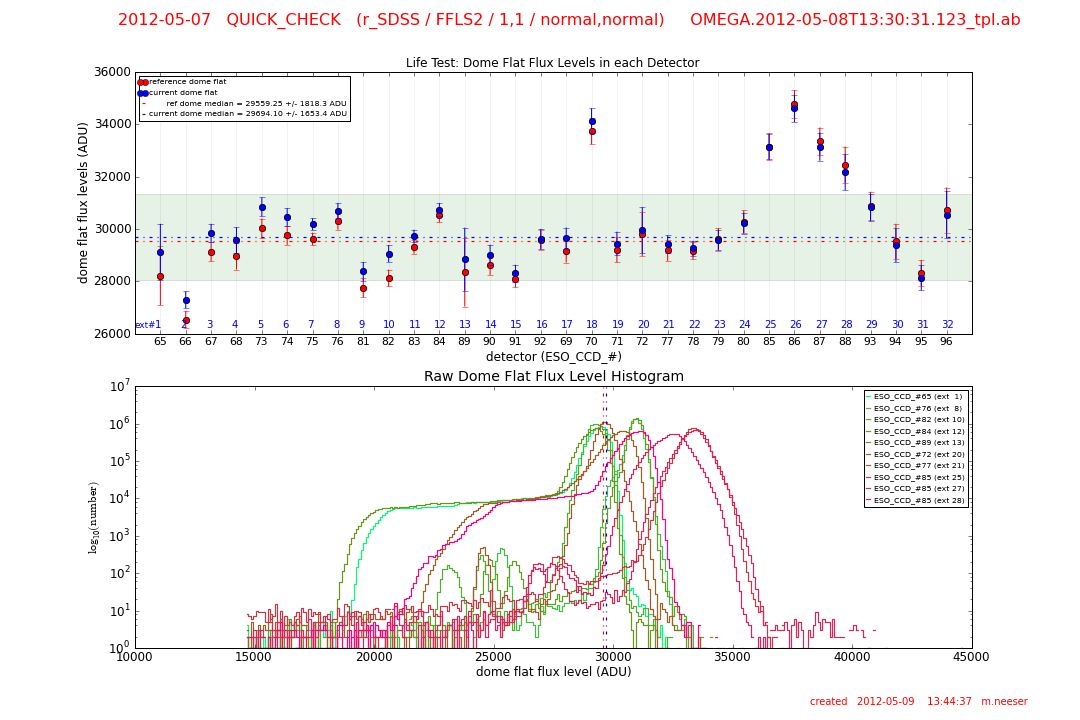During normal VST/OmegaCAM operations a single, quick-check, DOME flat frame is taken to test the health of the instrument and the dome flat lamp. Most frequently, the quick-check dome flat is made using the r_SDSS filter and dome flat lamp1 (FFLS1). The pipeline applies a bias-correction, trims the images, and creates a table with frame statistics (mean, median, and standard deviation) for each detector.
The pipeline creates one output fits table from its quick-check dome flat recipe (omega_qcheck):
OC_MLIF_<date>_1_1_normal_normal_<filter>.fits.
top
Quick-check DOME parameters trended
|
QC1 Health Check Plots
The QC1 health check plots for the RAW OmegaCAM dome flats are divided into 5 separate linked pages, each monitoring the flux level and rms with two dome flat lamps (FFLS1 and FFLS2 as read from the header keywords: INS.LAMP1.ID or INS.LAMP2.ID), and a detailed look at the flux level of six detectors.
- for each dome flat lamp (FFLS1 or FFLS2):
- median flux level averaged over all 32 detectors (ADU)
- median flux level for each detector (ADU)
- score outliers
- standard deviation over all 32 detectors (ADU)
- standard deviation for each detector (ADU)
- score outliers
- a detailed (normalized) flux level for the less stable detectors ESO_CCD_#82, #87, and #88 as compared to the more stable detectors #89, #73, and #80
QC1 parameters (trended for each individual detector)
| Parameter |
Table: Name (QC1 database) |
Description of Procedure |
| median level of quick-check dome flat |
omegacam_qcheck: qc.qcheck.median |
The median level of the quick-check dome flat frame for each extension (ADU). |
mean level of quick-check dome flat
|
omegacam_qcheck: qc.qcheck.mean |
The mean level of the quick-check dome flat frame for each extension (ADU). |
| standard deviation of quick-check dome flat |
omegacam_dome: qc.qcheck.std |
The standard deviation of the quick-check dome flat frame for each extension (ADU). |
| average temperature of the two detector plate probes |
omegacam_dome: qc.temp.mosaic.plate |
The average value of the header temperature keyword DET.TLM5 and DET.TLM8, both of which probe the temperature of the mosaic plate (Kelvin). |
QC Reports for the Quick-Check DOME flat

QC Report:
top: displays the median level of the dome flat (in ADU) for each of the 32 OmegaCAM detectors. The blue points are for the current dome flat frame, while the red points are the reference values. The median dome flat level of all detectors is indicated as a blue line (current value) and as a red line (reference value) and are listed in the frame legend.
The shaded green area indicates the +/- 1 sigma value of the RON for all current detectors.
bottom: a read-out noise histogram indicating the RON (in ADU) vs. the number of detectors having this read noise. The blue histogram indicates the current read noise frame, while the red histogram is the reference frame.
Trending and Issues
The quick-check dome flat is intended purely as a health/quality control check of the instrument.
The quick-check dome flat levels, as seen for each detector in the QC report, should be with ~1000 counts of its reference value. A systematic difference (i.e. all detectors have lower flux levels when compared to the reference may indicate a problem with the dome flat lamp. Two lamps (FFLS1 and FFLS2 can be used. The QC script can distinquish between the two and will use a reference frame with the correct lamp.
Quick-check dome flat levels below 1000 counts indicates that either the M1 covers were in place during the exposure, or that the dome flat lamp was not turned on.
Paranal should be informed and the AB rejected.
History
OmegaCAM DOME flats tend to be very stable.
2014-01-13: Main dome flat lamp FFLS1 (lamp1)
showed failing trend. Decision was taken to swap the role of the
lamps and treat the FFLS2 (lamp2) as the main one. HealthCheck plots for "dome:quick_check" were reorganized accordingly. Later it became clear that the decrease in flux was due to installation of the baffling system on 2014-01-08 and further on 2014-04-06.
2014-04-25: Dome flat lamp FFLS1 (lamp1) again considered as the main lamp used for monitoring.
HealthCheck plots for "dome:quick_check" were reorganized accordingly.
|
![[ ESO ]](/images/eso-logo.gif)
![[ ESO ]](/images/eso-logo.gif)
